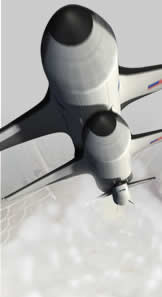|
Veridian /Wright Patterson AFRL/VACD
|
USL is teamed with
Veridian
to support Wright Patterson
AFRL/VACD in providing a comprehensive simulation test and
analysis capability to support the Space Access Simulation (SAS)
Evaluation and Development for the Simulation-based Technology
Assessment (STA) Program. This work will focus on development
of modeling and simulation tools and environments to assess space
vehicle technology development and to provide a space access
simulation capability for the Air Force Research Laboratory. The
SAS will be used to evaluate space vehicle concepts that are
currently being developed in the Air Vehicle Directorate in the
Air Force Research Laboratory (AFRL/VA). The work supports
AFRL/VACD's work with AFRL/VAAA (Space Operating Vehicle (SOV) team),
AFRL/VAOT (Space Access Focus Area), AFRL/HE, and also AFRL/VS to
design and develop a suitable capability to test and analyze space
vehicle technologies, missions, and design concepts.
|









